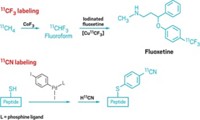Advertisement
Grab your lab coat. Let's get started
Welcome!
Welcome!
Create an account below to get 6 C&EN articles per month, receive newsletters and more - all free.
It seems this is your first time logging in online. Please enter the following information to continue.
As an ACS member you automatically get access to this site. All we need is few more details to create your reading experience.
Not you? Sign in with a different account.
Not you? Sign in with a different account.
ERROR 1
ERROR 1
ERROR 2
ERROR 2
ERROR 2
ERROR 2
ERROR 2
Password and Confirm password must match.
If you have an ACS member number, please enter it here so we can link this account to your membership. (optional)
ERROR 2
ACS values your privacy. By submitting your information, you are gaining access to C&EN and subscribing to our weekly newsletter. We use the information you provide to make your reading experience better, and we will never sell your data to third party members.
Synthesis
Fast Route To Radiolabeled Formaldehyde
July 14, 2008
| A version of this story appeared in
Volume 86, Issue 28
Scientists and doctors may soon have access to a greater number of radiotracer compounds for positron emission tomography (PET), thanks to a new method for making radiolabeled formaldehyde. Compounds containing carbon-11 are popular radiotracers for PET scans, but the radionuclide's 20-minute half-life presents a challenge to chemists: The process of generating a 11C labeling reagent, synthesizing a tracer molecule, and then purifying that compound so that it can be injected into a patient waiting for a PET scan must all take place before the radioactive signal decays. Methylation with [11C]methyl iodide is the most common radiolabeling reaction, but this restricts radiotracers to compounds with pendant methyl groups. A team led by Jacob M. Hooker of Brookhaven National Laboratory now has developed a simple and rapid route to [11C] formaldehyde, thereby expanding the types of radiolabeling reactions (Angew. Chem. Int. Ed., DOI: 10.1002/anie.200800991). The synthesis uses [11C] methyl iodide to methylate trimethylamine N-oxide. [11C] formaldehyde is subsequently generated via elimination of trimethylamine. Hooker's group was able to make the reaction work with radiolabeled reagents in a matter of minutes under mild conditions.





Join the conversation
Contact the reporter
Submit a Letter to the Editor for publication
Engage with us on Twitter